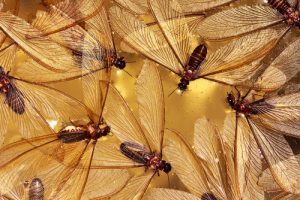Why Do Termites Swarm?
By Chris Williams on April 5, 2012.
Q. Yesterday we saw termites flying out from a stump in our yard and birds were picking them off. Why do termites swarm?
A. Reproduction is a strong force that cannot be denied. The whole purpose of a termite swarm is to start new little termite colonies. Once a termite colony reaches a certain size, it starts to produce “primary reproductives” or swarmers. While worker termites are wingless and sterile, the swarmers are winged males and females capable of reproduction.
 Swarming serves to disperse termites to new locations and allows them to pair with a mate. Swarming termites drop to the ground, shed their wings and their inhibitions, and pair off to dig a new nest in the soil. Once the “royal cell” is complete, mating occurs and new little worker termites eventually result.
Swarming serves to disperse termites to new locations and allows them to pair with a mate. Swarming termites drop to the ground, shed their wings and their inhibitions, and pair off to dig a new nest in the soil. Once the “royal cell” is complete, mating occurs and new little worker termites eventually result.
Most subterranean termite colonies don’t send out swarmers until the colony is several years old. Really big swarms don’t occur until the colony has been in business for 8 to 10 years. The fully developed swarmers sometimes wait in the colony for months for just the right conditions of temperature and humidity to begin their flight. A warm day after rain often triggers the swarm.
But alas, the promise of a happy life together may be short-lived. It’s risky business to leave your nice colony in the soil for a short life with wings but with no place to go. Only a small percentage of termite couples survive. Swarming termites are a favorite food for many insects, birds, and other animals that have little regard for termite romance. And termites that swarm indoors rarely find their way outside to soil and the chance to start a new colony.
For more on termite swarmers, see Termites in our Pest Library.